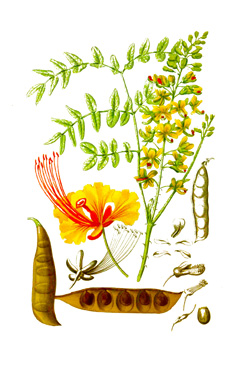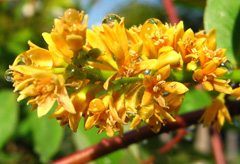 |
|
https://edibleplants.org/ |
 |
| mauroguanandi flickr |
Translate this page:
Summary
Found in South America, Spiny Holdback, Caesalpinia spinosa, is a spiny, evergreen tree up to 8m tall and 5 m wide. It has an erect and slender trunk and it is rich in tannins. Seedpods yield a powder that is used as eyewash. The seed?s endosperm is a source of gum used as a thickening agent and stabilizer in food. Common names: Spiny Holdback, Tailin, Vainilla, Tallo, Tara.
Physical Characteristics

 Caesalpinia spinosa is an evergreen Tree growing to 6 m (19ft) by 6 m (19ft) at a fast rate.
Caesalpinia spinosa is an evergreen Tree growing to 6 m (19ft) by 6 m (19ft) at a fast rate.
See above for USDA hardiness. It is hardy to UK zone 10 and is frost tender.
It is noted for attracting wildlife.
Suitable for: light (sandy), medium (loamy) and heavy (clay) soils and prefers well-drained soil. Suitable pH: neutral and basic (mildly alkaline) soils and can grow in very alkaline soils.
It can grow in semi-shade (light woodland) or no shade. It prefers moist soil. The plant is not wind tolerant.
UK Hardiness Map
US Hardiness Map
Synonyms
Caesalpinia pectinata Cav. Caesalpinia tara Ruiz & Pav. Caesalpinia tinctoria (Kunth) Benth. Caesalp
Plant Habitats
Edible Uses
Edible Parts: Seed
Edible Uses: Gum
The endosperm of the seed (22% of the total seed weight) yields a gum of commercial value. It is a white to yellowish powder and consists chiefly of galactomannan-type polysaccharides. The gum is used as a thickening agent and stabilizer in the food industry[ 303 ].
References More on Edible Uses
Medicinal Uses
Plants For A Future can not take any responsibility for any adverse effects from the use of plants. Always seek advice from a professional before using a plant medicinally.
Febrifuge Ophthalmic
The powder contained within the seedpods is used as an eyewash[ 303 , 434 ]. An infusions of the pods is used in Peru for inflamed tonsils or washing wounds; it is also used for fevers, colds and stomach aches.
References More on Medicinal Uses
The Bookshop: Edible Plant Books
Our Latest books on Perennial Plants For Food Forests and Permaculture Gardens in paperback or digital formats.

Edible Tropical Plants
Food Forest Plants for Hotter Conditions: 250+ Plants For Tropical Food Forests & Permaculture Gardens.
More

Edible Temperate Plants
Plants for Your Food Forest: 500 Plants for Temperate Food Forests & Permaculture Gardens.
More

More Books
PFAF have eight books available in paperback and digital formats. Browse the shop for more information.
Shop Now
Other Uses
Dye Fencing Gum Tannin Wood
Other uses rating: High (4/5). Agroforestry Uses: The plant is sometimes grown as a live fence in Peru[303. Other Uses: The pods contain around 50% tannin, about twice as much as sumac (Rhus spp)[ 303 , 434 ]. An excellent source of environmentally friendly tannins (tara tannins) most commonly used in the manufacture of automotive and furniture leathers. The high content of hydrolysable tan has made it interesting for the extraction of gallic acid and ink manufacturing[ 303 ]. Sticks of the wood are split up finely; urine is poured over the pieces of wood, which are then set out in the sun. Urine is repeatedly poured over them, until they are well soaked. After airing, the sticks are boiled in water, together with red tiri (Stereoxylon resinosum) and woollen or cotton fabrics. The dye produced is a purplish red[ 630 ]. The dried fruit is boiled with a bit of soot and woollens soaked in iron sulphate or vitriol without acid. The fabric produced will be dyed a beautiful clove colour[ 630 ]. A gum is obtained from the seed. It is used in the food industry[ 303 ]. The wood is durable[ 303 ]. This plant is attractive to bees, butterflies and/or birds. Grown as an ornamental plant because of its large colorful flowers and pods.
Special Uses
Attracts Wildlife
References More on Other Uses
Cultivation details
A plant of higher elevations in the Andean mountains, it has been cultivated from the warm temperate to the very dry and seasonally wet tropics. It can grow in areas where the mean annual temperatures are within the range 14° - 28°c, and the mean annual rainfall is in the range 660 - 1,730mm[ 303 ]. Succeeds in full sun and partial sun[ 423 ]. Prefers a pH in the range 6.8 - 7.5[ 303 ]. A fast-growing plant[ 423 ]. Although many species within the family Fabaceae have a symbiotic relationship with soil bacteria, this species is said to be devoid of such a relationship and therefore does not fix atmospheric nitrogen[ 755 ].
References Carbon Farming Information and Carbon Sequestration Information
Temperature Converter
Type a value in the Celsius field to convert the value to Fahrenheit:
Fahrenheit:
The PFAF Bookshop
Plants For A Future have a number of books available in paperback and digital form. Book titles include Edible Plants, Edible Perennials, Edible Trees,Edible Shrubs, Woodland Gardening, and Temperate Food Forest Plants. Our new book is Food Forest Plants For Hotter Conditions (Tropical and Sub-Tropical).
Shop Now
Plant Propagation
Seed - it has a hard seedcoat and benefits from scarification before sowing in order to speed up and improve germination[ 303 ]. This can usually be done by pouring a small amount of nearly boiling water on the seeds (being careful not to cook them!) and then soaking them for 12 - 24 hours in warm water. By this time they should have imbibed moisture and swollen - if they have not, then carefully make a nick in the seedcoat (being careful not to damage the embryo) and soak for a further 12 hours before sowing. Direct sow outdoors in fall . Seed Collecting: Allow seedheads to dry on plants; remove and collect seeds. Properly cleaned, seed can be successfully stored.
Other Names
If available other names are mentioned here
Spiny Holdback, Caesalpinia spinosa. Common names: Spiny Holdback, Tailin, Vainilla, Tallo, Tara.
Native Range
SOUTHERN AMERICA: Venezuela, Bolivia, Colombia, Ecuador, Peru, Argentina, Chile (north)
Weed Potential
Right plant wrong place. We are currently updating this section.
Please note that a plant may be invasive in one area but may not in your area so it's worth checking.
None Known
Conservation Status
IUCN Red List of Threatened Plants Status : This taxon has not yet been assessed.

Growth: S = slow M = medium F = fast. Soil: L = light (sandy) M = medium H = heavy (clay). pH: A = acid N = neutral B = basic (alkaline). Shade: F = full shade S = semi-shade N = no shade. Moisture: D = dry M = Moist We = wet Wa = water.
Now available:
Food Forest Plants for Mediterranean Conditions
350+ Perennial Plants For Mediterranean and Drier Food Forests and Permaculture Gardens.
[Paperback and eBook]
This is the third in Plants For A Future's series of plant guides for food forests tailored to
specific climate zones. Following volumes on temperate and tropical ecosystems, this book focuses
on species suited to Mediterranean conditions—regions with hot, dry summers and cool, wet winters,
often facing the added challenge of climate change.
Read More
Expert comment
Author
(Molina) Kuntze
Botanical References
Links / References
For a list of references used on this page please go here
A special thanks to Ken Fern for some of the information used on this page.
Readers comment
| Add a comment |
|
If you have important information about this plant that may help other users please add a comment or link below. Only comments or links that are felt to be directly relevant to a plant will be included. If you think a comment/link or information contained on this page is inaccurate or misleading we would welcome your feedback at [email protected]. If you have questions about a plant please use the Forum on this website as we do not have the resources to answer questions ourselves.
* Please note: the comments by website users are not necessarily those held by PFAF and may give misleading or inaccurate information.
To leave a comment please Register or login here All comments need to be approved so will not appear immediately.
|
Subject : Caesalpinia spinosa
|
|
|
|